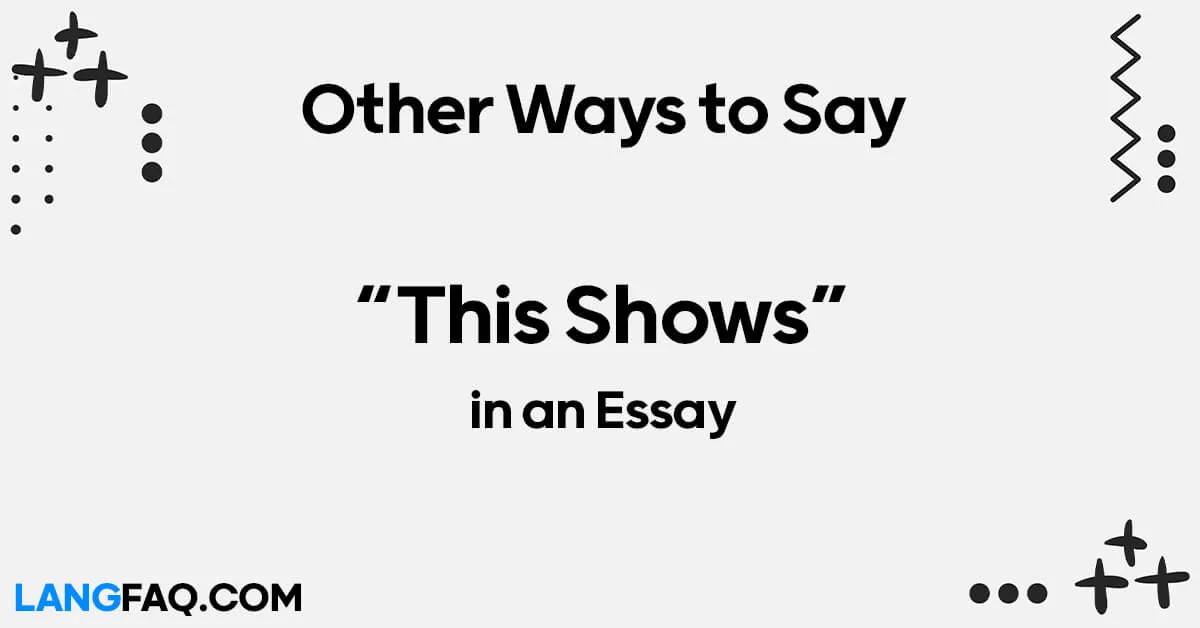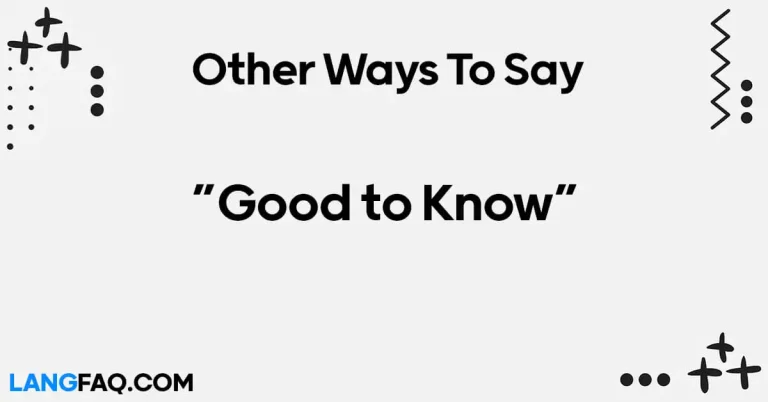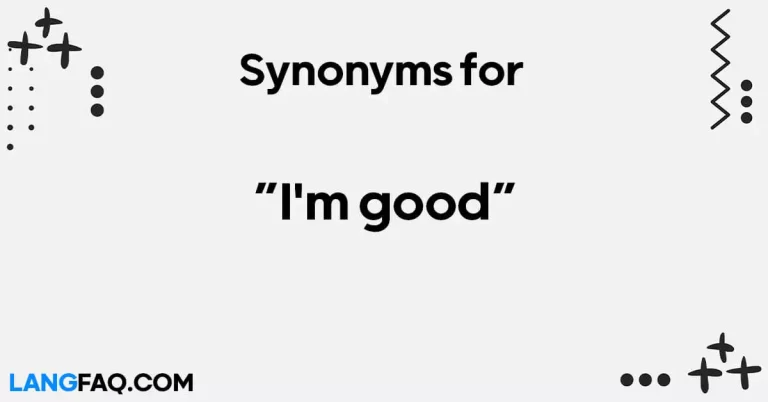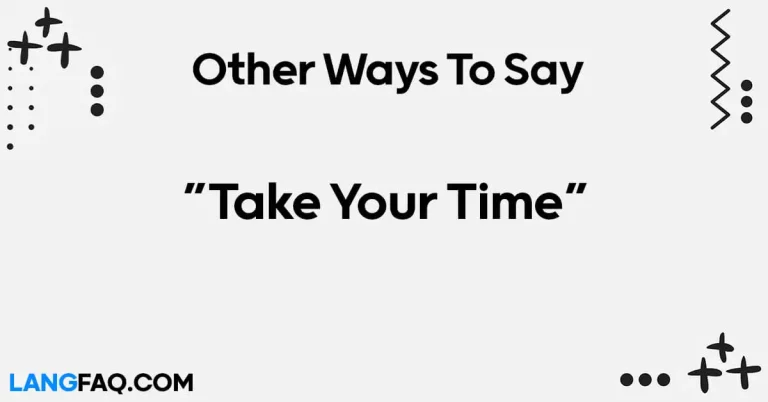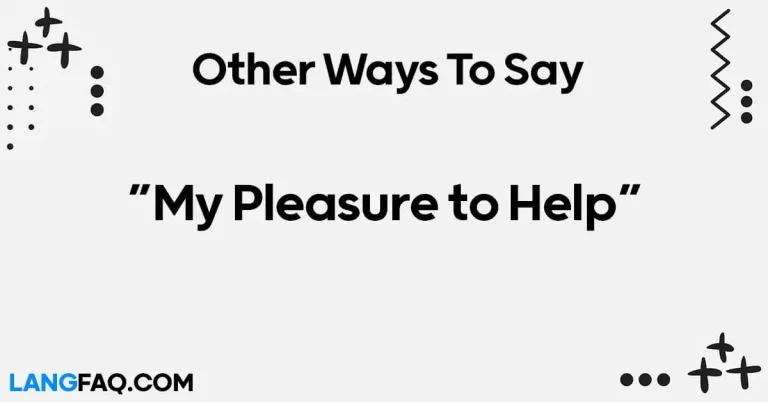Embarking on the journey of expressive writing requires the adept use of language. Unveiling alternative phrases for “This Shows” can transform your essays into compelling narratives. In this article, we delve into 12 distinctive expressions, enhancing your ability to articulate thoughts with finesse. Let’s embark on this linguistic exploration.
12 Other Words for “This Shows”
Here are 12 alternative expressions for “This Shows”:
- Evidently
- Demonstrates
- Illustrates
- Reveals
- Displays
- Manifests
- Portrays
- Exemplifies
- Conveys
- Signifies
- Exhibits
- Indicates
Here’s a table with meanings and examples for the 12 alternative expressions for “This Shows”:
| Alternative Expression | Meaning | Example |
|---|---|---|
| Evidently | Clearly and unmistakably | The data EVIDENTLY indicates a significant upward trend. |
| Demonstrates | Clearly shows or proves | The experiment DEMONSTRATES the effectiveness of the method. |
| Illustrates | Provides a clear example or picture | The graph ILLUSTRATES the correlation between variables. |
| Reveals | Unveils or brings to light | The investigation REVEALS new insights into the matter. |
| Displays | Exhibits or showcases | The art gallery DISPLAYS a stunning collection of paintings. |
| Manifests | Clearly shows or embodies in a tangible way | His dedication MANIFESTS in the consistent quality of work. |
| Portrays | Represents or describes in a particular way | The movie PORTRAYS the harsh realities of urban life. |
| Exemplifies | Serves as a typical example or illustration | The successful entrepreneur EXEMPLIFIES resilience. |
| Conveys | Communicates or expresses | The speaker CONVEYS the urgency of addressing climate change. |
| Signifies | Indicates or represents something specific | The ringing bell SIGNIFIES the end of the school day. |
| Exhibits | Displays or presents | The museum EXHIBITS artifacts from ancient civilizations. |
| Indicates | Points out or shows a particular direction | The compass INDICATES the way to the north. |
These alternative expressions provide a rich tapestry of language to convey ideas effectively in writing. By diversifying your vocabulary, you can add nuance and depth to your communication, ensuring that your message resonates with clarity and impact.
Is It Correct to Say “This Shows”?
Certainly, using the phrase “This shows” is grammatically correct, and it’s a commonly employed expression in writing and speaking. However, to enhance the variety and sophistication of your language, you might consider incorporating alternative expressions for greater impact.
The phrase “This shows” is straightforward and direct, making it suitable for various contexts, from academic writing to everyday communication. It efficiently conveys the idea that something is being demonstrated or revealed. For example:
- “The data analysis is thorough, and this shows the researcher’s attention to detail.”
- “She consistently meets deadlines, and this shows her commitment to the project.”
While grammatically correct, it’s beneficial to diversify your vocabulary to prevent repetition and add nuance to your expression. Utilizing alternatives such as “demonstrates,” “illustrates,” “reveals,” or any of the other suggested terms in this article can elevate the quality of your writing, providing a more varied and sophisticated linguistic palette.
Professional Mail Example With “This Shows”
Subject: Project Progress Update – Milestone Achieved
Dear [Recipient’s Name],
I trust this email finds you well. I am writing to provide you with an update on the current status of the project.
We have successfully completed the initial phase of the project, and I am pleased to inform you that our team’s collective efforts have borne fruit. This shows the dedication and commitment we have invested in ensuring the project’s success.
To delve into specifics, the data analysis, as outlined in our project plan, has been meticulously executed. The comprehensive report generated from this analysis not only meets but exceeds the expected standards. This shows our attention to detail and commitment to delivering quality outcomes.
Moreover, our collaborative approach with the cross-functional teams has significantly contributed to the seamless progression of tasks. This shows the effectiveness of our teamwork and the positive impact it has on project timelines.
In the coming weeks, we are poised to enter the next phase, building upon the solid foundation laid during this initial stage. We are confident that the momentum we’ve gained will propel us toward meeting and even surpassing our project objectives.
I welcome any feedback or suggestions you may have as we proceed. Your insights are invaluable to us, and we are committed to ensuring the project aligns with your expectations.
Thank you for your continued support and trust in our team’s capabilities. We look forward to achieving further milestones together.
Best regards,
[Your Full Name] [Your Position] [Your Contact Information]
1. Evidently: A Clear Path to Clarity
Meaning:
“Evidently” is an adverb used to convey a clear and unmistakable indication of a situation or fact.
Usage:
In formal writing, “evidently” can enhance the expression of certainties or observations without leaving room for doubt. In informal contexts, it adds a touch of confidence to casual conversations.
Example:
Formal: The research data EVIDENTLY supports the hypothesis, showcasing a significant correlation between variables.
Informal: EVIDENTLY, she has a talent for turning challenges into opportunities.
Email Sample:
Subject: Evidently Successful Project Results
Dear [Recipient],
I hope this message finds you well. I am pleased to inform you that our recent project has EVIDENTLY exceeded expectations. Attached is a detailed report for your review.
Best regards, [Your Name]
Variation:
- Formal Variation: It is EVIDENT FROM THE ANALYSIS that our strategy is effective.
- Informal Variation: EVIDENTLY, you aced that presentation!
Insight:
Using “evidently” brings an air of authority to your statements, making it suitable for professional communication where clarity is paramount.
2. Demonstrates: Showcasing Excellence
Meaning:
“Demonstrates” is a verb indicating a clear and conclusive presentation of a concept, skill, or fact.
Usage:
In formal writing, “demonstrates” is powerful for illustrating achievements or capabilities. In casual settings, it can highlight personal skills or achievements.
Example:
Formal: The experiment DEMONSTRATES the effectiveness of the proposed solution.
Informal: He DEMONSTRATES exceptional leadership in every project.
Email Sample:
Subject: Demonstrates Strong Leadership
Dear [Recipient],
I wanted to bring to your attention how [Name] consistently DEMONSTRATES exceptional leadership skills in our team. His recent contributions have been noteworthy.
Best regards, [Your Name]
Variation:
- Formal Variation: The report DEMONSTRATES the company’s commitment to sustainability.
- Informal Variation: She DEMONSTRATES creativity in every design.
Insight:
“Demonstrates” adds weight to your assertions, making it ideal for showcasing accomplishments in professional and personal contexts.
3. Illustrates: Painting Pictures with Words
Meaning:
“Illustrates” is a verb conveying the creation of a clear and vivid picture through words, often used to explain or clarify.
Usage:
Formally, “illustrates” is potent for elucidating complex concepts. In informal communication, it lends a creative flair to storytelling.
Example:
Formal: The graph ILLUSTRATES the correlation between input and output variables.
Informal: Let me ILLUSTRATE my point with a personal anecdote.
Email Sample:
Subject: Illustrates Our Progress
Dear [Recipient],
The attached report ILLUSTRATES the remarkable progress we’ve made this quarter. Feel free to reach out if you have any questions.
Best regards, [Your Name]
Variation:
- Formal Variation: The case study ILLUSTRATES the effectiveness of the proposed strategy.
- Informal Variation: His experience ILLUSTRATES the power of resilience.
Insight:
“Illustrates” is a versatile term, suitable for both technical explanations and adding a storytelling element to your conversations.
4. Reveals: Unveiling Truths
Meaning:
“Reveals” is a verb indicating the disclosure or exposure of something previously hidden or unknown.
Usage:
In formal contexts, “reveals” is impactful for unveiling discoveries or insights. Informally, it adds a dramatic touch to everyday storytelling.
Example:
Formal: The investigation REVEALS new dimensions in our understanding of the phenomenon.
Informal: Guess what the interview REVEALS about his unconventional career path!
Email Sample:
Subject: Reveals Key Findings
Dear [Recipient],
The attached document REVEALS key findings from our recent market analysis. Your insights on this matter would be valuable.
Best regards, [Your Name]
Variation:
- Formal Variation: The research REVEALS a previously unknown correlation.
- Informal Variation: This documentary REVEALS the hidden gems of our city.
Insight:
“Reveals” adds a touch of intrigue to your narrative, making it suitable for both professional revelations and casual storytelling.
5. Displays: Showcasing for Impact
Meaning:
“Displays” is a verb indicating the presentation or exhibition of something for observation or admiration.
Usage:
In formal writing, “displays” is apt for showcasing achievements or results. Informally, it adds flair to expressing personal accomplishments.
Example:
Formal: The conference room DISPLAYS a collection of awards highlighting our achievements.
Informal: She DISPLAYS a remarkable level of dedication to her craft.
Email Sample:
Subject: Displays of Excellence
Dear [Recipient],
Our team consistently DISPLAYS excellence in every project. Please find the attached report for your review.
Best regards, [Your Name]
Variation:
- Formal Variation: The showroom DISPLAYS the latest innovations in technology.
- Informal Variation: He DISPLAYS unmatched passion for his hobbies.
Insight:
“Displays” emphasizes visibility and impact, making it suitable for professional and personal contexts, especially when showcasing accomplishments.
6. Manifests: Bringing Ideas to Life
Meaning:
“Manifests” is a verb signifying the clear and tangible expression or demonstration of an idea, quality, or feeling.
Usage:
In formal settings, “manifests” is potent for portraying tangible outcomes. Informally, it adds a touch of vividness to personal narratives.
Example:
Formal: His dedication MANIFESTS in the consistent quality of work delivered.
Informal: The team spirit MANIFESTS in our successful collaborations.
Email Sample:
Subject: Manifests Exceptional Performance
Dear [Recipient],
I wanted to highlight how [Name]’s effort MANIFESTS in the exceptional performance of our recent project. Please find the details attached.
Best regards, [Your Name]
Variation:
- Formal Variation: The initiative MANIFESTS the organization’s commitment to sustainability.
- Informal Variation: His kindness MANIFESTS in the little things he does for others.
Insight:
“Manifests” adds a layer of tangibility to your descriptions, making it suitable for both professional and personal contexts, especially when emphasizing dedication or commitment.
7. Portrays: Crafting a Narrative
Meaning:
“Portrays” is a verb conveying the representation or depiction of something through words, images, or actions.
Usage:
Formally, “portrays” is effective for creating a narrative or analysis. Informally, it adds a storytelling element to personal anecdotes.
Example:
Formal: The movie PORTRAYS the harsh realities of urban life.
Informal: Let me PORTRAY a scene from my recent travel adventure.
Email Sample:
Subject: Portrays Our Brand Identity
Dear [Recipient],
I trust this message finds you well. The attached document PORTRAYS our brand identity and the values we hold dear.
Best regards, [Your Name]
Variation:
- Formal Variation: The report PORTRAYS the evolving landscape of our industry.
- Informal Variation: His artwork beautifully PORTRAYS the essence of nature.
Insight:
“Portrays” invites readers to visualize, making it suitable for both analytical writing and creative storytelling.
8. Exemplifies: Setting a Standard
Meaning:
“Exemplifies” is a verb indicating the action of serving as a typical example or illustration of a concept or quality.
Usage:
In formal writing, “exemplifies” is powerful for setting standards or showcasing ideal scenarios. Informally, it adds a touch of admiration to personal narratives.
Example:
Formal: The successful entrepreneur EXEMPLIFIES resilience and adaptability.
Informal: She truly EXEMPLIFIES the meaning of generosity.
Email Sample:
Subject: Exemplifies Excellence
Dear [Recipient],
I am delighted to share how [Name] consistently EXEMPLIFIES excellence in their role. Please find the details attached.
Best regards, [Your Name]
Variation:
- Formal Variation: The project EXEMPLIFIES the organization’s commitment to innovation.
- Informal Variation: Your dedication EXEMPLIFIES true friendship.
Insight:
“Exemplifies” adds a layer of admiration to your descriptions, making it suitable for both professional and personal contexts, especially when highlighting exemplary qualities.
9. Conveys: Communicating with Precision
Meaning:
“Conveys” is a verb indicating the clear and effective communication of an idea, feeling, or information.
Usage:
In formal writing, “conveys” is essential for emphasizing effective communication. Informally, it brings a touch of intention to casual conversations.
Example:
Formal: The speaker CONVEYS the urgency of addressing climate change in his presentation.
Informal: She CONVEYS her excitement for the upcoming event through animated gestures.
Email Sample:
Subject: Conveys Key Messages
Dear [Recipient],
The attached document CONVEYS the key messages from our recent meeting. Your feedback is highly appreciated.
Best regards, [Your Name]
Variation:
- Formal Variation: The artwork CONVEYS the artist’s commentary on societal issues.
- Informal Variation: His smile CONVEYS a sense of genuine happiness.
Insight:
“Conveys” adds a layer of intention to your communication, making it suitable for both formal presentations and casual expressions.
10. Signifies: Indicating Importance
Meaning:
“Signifies” is a verb indicating the action of conveying meaning, importance, or intention.
Usage:
Formally, “signifies” is potent for indicating significance. Informally, it adds depth to expressions of importance or intent.
Example:
Formal: The ringing bell SIGNIFIES the end of the school day.
Informal: Their shared laughter SIGNIFIES a strong bond.
Email Sample:
Subject: Signifies Milestone Achievement
Dear [Recipient],
I am thrilled to share that our recent accomplishment SIGNIFIES a significant milestone for the team. Please find the details attached.
Best regards, [Your Name]
Variation:
- Formal Variation: The decision SIGNIFIES a strategic shift in our approach.
- Informal Variation: Your support SIGNIFIES a lot to me.
Insight:
“Signifies” adds gravitas to your descriptions, making it suitable for both formal announcements and personal expressions of importance.
11. Exhibits: Showcasing for Inspection
Meaning:
“Exhibits” is a verb indicating the action of displaying or presenting something for observation or inspection.
Usage:
In formal contexts, “exhibits” is potent for showcasing achievements or qualities. Informally, it adds flair to expressing personal accomplishments.
Example:
Formal: The museum EXHIBITS artifacts from ancient civilizations.
Informal: He always EXHIBITS a positive attitude, no matter the circumstance.
Email Sample:
Subject: Exhibits Exceptional Skills
Dear [Recipient],
I am pleased to inform you that [Name] consistently EXHIBITS exceptional skills in project management. Please find the details attached.
Best regards, [Your Name]
Variation:
- Formal Variation: The gallery EXHIBITS a diverse collection of contemporary art.
- Informal Variation: His personality EXHIBITS warmth and kindness.
Insight:
“Exhibits” emphasizes visibility and impact, making it suitable for professional and personal contexts, especially when showcasing accomplishments.
12. Indicates: Pointing Towards Understanding
Meaning:
“Indicates” is a verb indicating the action of pointing out or showing a particular direction, meaning, or result.
Usage:
In formal writing, “indicates” is crucial for pointing towards insights or findings. Informally, it adds a touch of direction to casual conversations.
Example:
Formal: The compass INDICATES the way to the north.
Informal: His expression INDICATES genuine interest in the topic.
Email Sample:
Subject: Indicates Project Progress
Dear [Recipient],
The attached report INDICATES significant progress in our ongoing project. Your thoughts on this matter would be valuable.
Best regards, [Your Name]
Variation:
- Formal Variation: The data INDICATES a positive trend in customer satisfaction.
- Informal Variation: Your gesture INDICATES a caring attitude.
Insight:
“Indicates” adds precision to your descriptions, making it suitable for both formal reports and casual expressions of direction.
FAQs
Q: How can I seamlessly incorporate these alternatives into my essay? A: Integrate these alternatives based on the context of your writing. Experiment with each to discover which resonates best with your style.
Q: Is it necessary to use all 12 alternatives in one essay? A: No, select alternatives based on relevance and variety. Using a mix adds depth to your writing without overwhelming the reader.
Q: Can these alternatives be applied to any type of essay? A: Absolutely! Whether it’s a persuasive piece or an informative essay, these alternatives enhance expression in various contexts.
Q: Why is expressive writing important in essays? A: Expressive writing captivates readers, making your essay memorable. It adds a personal touch, fostering a connection between the writer and the audience.
Q: Are these alternatives suitable for academic essays? A: Yes, these alternatives elevate the quality of academic writing, making your essays more engaging and impactful.
Q: How do I avoid overusing these alternatives in my essay? A: Use a mix of alternatives and vary your language to maintain a natural flow. Overusing any term can diminish its impact.
Conclusion
Mastering alternative expressions for “This Shows” is a transformative step in refining your essay-writing skills. The nuances offered by these alternatives open new avenues for expression, ensuring your essays stand out with clarity and impact.

